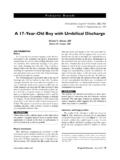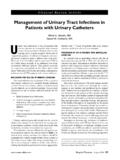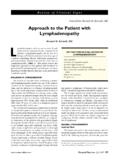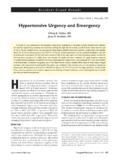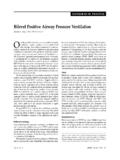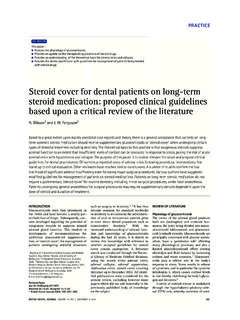Transcription of Update on the Diagnosis and Treatment of …
1 298 JCOM June 2008 Vol. 15, No. 6 stUdyinitial presentationA 25- year -old woman presents to her physician with symptoms of fatigue , headaches, and fluctuat-ing weight. On examination, vital signs are within normal range. Body mass index (BMI) is 28 kg/m2. Thyroid examina-tion is unremarkable. A thyroid-stimulating hormone (TSH) level is ordered and found to be low at mIU/L (reference range, mIU/L). Free levorotatory thyroxine (T4) and free triiodothyronine (T3) levels are subsequently checked and found to be normal. How should the results of the patient s thyroid function tests be interpreted? A patient with low TSH and normal T4 and T3 is consid-ered to have subclinical hyperthyroidism.
2 Typically, these patients do not have clear signs and symptoms of hyper-thyroidism. The prevalence of subclinical hyperthyroidism ranges from to This variability is partly due to differences among studies in the definition of a low serum TSH value [1 4]. The causes of subclinical hyperthyroidism are similar to those of overt hyperthyroidism (Table 1). The most common causes of subclinical hyperthyroidism are Exogenous administration of levothyroxine for treating hypothyroidism. Among patients taking levothyroxine, as many as 25% may have low serum TSH values [5] Autonomously functioning thyroid adenomas and multinodular goiters Subacute thyroiditis Less commonly, Graves diseaseUpdate on the Diagnosis and Treatment of HyperthyroidismCase Study and Commentary, Elias S.
3 Siraj, MD From the Department of Medicine, Section of Endocrinology, Diabetes and Metabolism, Temple University School of Medicine, Philadelphia, article has a companion CME exam that follows the article. To earn credit, read the article and com-plete the CME evaluation on pages 306 and 307. Estimated time to complete this activity is 1 hour. Faculty disclosure information appears on page 304. Release date: 15 June 2008; valid for credit through 30 June AudiencePrimary care Needs AddressedSigns and symptoms of hyperthyroidism are wide-ranging and the frequency and severity of symp-toms can vary, which makes Diagnosis a chal-lenge. Primary care physicians are often the first to evaluate these patients.
4 A detailed evaluation that includes questions about extent and duration of symptoms, past medical history, family history, physical examination (including thyroid examina-tion), and appropriate laboratory tests can help guide the treating physician to the etiology. Proper management depends on properly identifying the cause of hyperthyroidism. Regular monitoring for changes in thyroid function is required, as progno-sis can be adversely affected if a euthyroid state is not objectivesAfter participating in this CME activity, primary care physicians should be able to1. Differentiate between etiologies of hyperthy-roidism2. Describe management options for subclinical hyperthyroidism3. Outline the typical course of and management strategies for subacute thyroiditis 4.
5 Understand the approach to Diagnosis and management of Graves disease5. Describe signs and symptoms of thyroid storm Cme jointly sponsored by Wayne state University school of medicine and Vol. 15, No. 6 June 2008 JCOM 299 CAse-BAsed revieW What is the clinical significance of subclinical hyper-thyroidism?The cardiovascular system and the skeletal system are the major organs affected by subclinical SystemAlthough some uncertainty remains, the majority of stud-ies in both exogenous and endogenous subclinical hyper-thyroidism showed that a prolonged hyperthyroid state may lead to lower bone mineral density [6,7]. This may be more pronounced in postmenopausal women.
6 Whether de-creased bone mineral density translates into increased risk of fractures is with overt hyperthyroidism, the frequency of atrial fibrillation is increased in patients with subclinical hyper-thyroidism [8,9]. Increased occurrence of tachycardia and ectopic beats may also be present. Possible induction of reentrant atrioventricular nodal tachycardia may occur in predisposed patients. Increases in cardiac contractility and left ventricular mass index as well as diastolic dysfunction may be seen. Mortality studies are not conclusive as to whether risk of mortality is increased [10,11]. Should subclinical hyperthyroidism be treated? The decision to treat subclinical hyperthyroidism depends on several factors, including the age of the patient, degree of abnormalities seen on thyroid function testing, and presence or absence of risk factors for cardiovascular and skeletal complications.
7 Observation is preferred if TSH level is greater than mIU/L and if there is a low risk of bone or cardiac complications. Treatment should be considered if the patient is elderly, TSH level is less than mIU/L, or if there is evidence of or high risk for cardiac and bone complications [12]. In cases of exogenous subclinical hyper-thyroidism, an attempt should be made to reduce the dose of the levothyroxine whenever the decision is made to treat, Treatment options include the following: b Blockers may help to control some mild symptoms and also have protective effect on the heart Antithyroid drugs or thionamides can be used in cases where b blockers are not considered to be ad-equate.
8 The goal of Treatment should be to normalize TSH and bring the T4 and T3 levels toward low- normal while at the same time avoiding hypothyroid symptoms Radioactive iodine Treatment is an option if radioac-tive iodine uptake and scan has shown autonomous nodule or a low-grade Graves disease In patients where there is evidence of osteopenia or osteoporosis, bisphosphonate Treatment may have to be initiated to protect the bonesDetails regarding Treatment options are described in more detail in subsequent sections. Case Follow-upGiven the asymptomatic nature of the patient s sub-clinical hyperthyroidism, a decision is made not to start Treatment . She is lost to follow-up for 3 years. The patient then presents 2 months after delivering a healthy baby complaining of dramatic weight loss, palpita-tions, and heat intolerance.
9 On examination, heart rate is 110 bpm. She also has tremor, lid lag, and a slightly enlarged, nontender thyroid. TSH is low at less than mIU/L, and T4 and T3 levels are high. What is the most likely Diagnosis ?Table 1. Common Causes of HyperthyroidismAutoimmune thyroid diseaseGraves diseaseAutonomous thyroid tissuesToxic adenomaToxic multinodular goiterSubacute thyroiditisSubacute granulomatous thyroiditis (painful)Subacute silent thyroiditis (painless)Includes postpartum thyroiditisExogenous thyroid hormone intakeExcessive replacement doseFactitious hyperthyroidismIodine-induced hyperthyroidism (including amiodarone)ThyroiditisAutonomous thyroid hormone productionOther rare causeshCG-mediated hyperthyroidism Struma ovariiTSH-mediated (eg, TSH-secreting pituitary adenoma)hCG = human chorionic gonadotropin; TSH = thyroid-stimulating JCOM June 2008 Vol.
10 15, No. 6 this patient is presenting in the immediate postpartum period, the physician should have a high degree of suspicion for postpartum thyroiditis, whose presentation is similar to subacute thyroiditis. There are other clinical clues that can be helpful in identifying the cause of hyperthyroidism (Table 2). Which tests may be helpful in the workup of the pa-tient with hyperthyroidism?Laboratory tests may help in differentiating between the causes of hyperthyroidism. Presence of TSH receptor anti-bodies, in particular thyroid-stimulating immunoglobulin, indicates Graves disease. Very high thyroglobulin levels are consistent with subacute radioactive iodine uptake and scan can be helpful in determining the etiology of hyperthyroidism and can help in directing Treatment .
